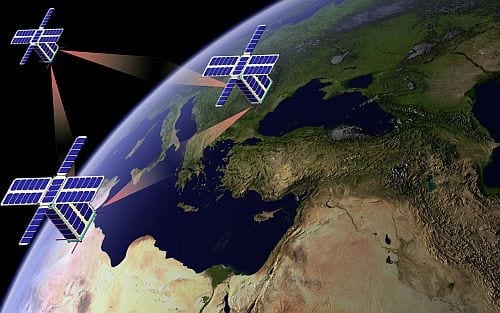Small satellites: Taking advantage of smartphones and other consumer technologies, tiny satellites are changing the space business
ALTHOUGH widely used, satellites are expensive to build and to launch. That began to change last year. On November 19th Orbital Sciences, an American company, launched a rocket from the Wallops Flight Facility in Virginia. It carried 29 satellites aloft and released them into low-Earth orbit, a record for a single mission. Thirty hours later, Kosmotras, a Russian joint-venture, carried 32 satellites into a similar orbit. Then, in January 2014, Orbital Sciences carried 33 satellites up to the International Space Station (ISS), where they were cast off a month later.
Many of these 94 satellites were built in a standard format known as a CubeSat, a 10cm (4 inch) cube weighing 1.3kg (2.9lb) or less. Some comprised units of two or three cubes. After a decade of fits and starts, during which some 75 CubeSats were launched, satellites of this scale and other small satellites are moving from being experimental kit to delivering useful scientific data and commercial services.
In the next five years or so some 1,000 nanosats, as small satellites of 1-10kg are called, are expected to be launched. Some will be smaller than a CubeSat; others bigger and heavier. Some are like a matryoshka doll: the Russian launch included a satellite that launched eight smaller ones, including four PocketQubes (a 5cm cube format). One of these smaller satellites, developed in Peru, released its own tiny bird.
Read more . . .
The Latest on: Nano satellites
[google_news title=”” keyword=”Nano satellites” num_posts=”10″ blurb_length=”0″ show_thumb=”left”]
via Google News
The Latest on: Nano satellites
- On Possibility Of Fully Sustainable Space Colony, ISRO Chief Said...on April 27, 2024 at 10:36 am
When Indian Space Research Organisation chairman S Somanath threw the floor open for questions over Instagram on Saturday, not only did people want to know about next Chandrayaan, asteroid missions ...
- ISRO Chief Faces Questions from Space Enthusiasts about Lunar Water Detectionon April 27, 2024 at 9:45 am
Questions on water on the moon and nano-satellite classes for 10-year-olds have to wait till next session.The session on April 27, between 6pm and 7pm, was attended by nearly 1,500 people.Somnath ...
- Narendra Tanejaon April 26, 2024 at 3:17 am
Find Narendra Taneja Latest News, Videos & Pictures on Narendra Taneja and see latest updates, news, information from NDTV.COM. Explore more on Narendra Taneja.
- Iron Man's Worst Nightmare Comes to Life in a Way the MCU Could Never Showon April 24, 2024 at 7:00 am
Forget Ultron or Thanos - while Tony Stark had some tough enemies, the MCU couldn't handle Iron Man's worst nightmare, who just showed up at his door.
- Global Krypton Gas Market Projected to Surpass US$ 306.1 million by 2033, Fueled by a 5.4% CAGR Expansion in Demandon April 19, 2024 at 11:03 am
In 2022, the global krypton gas market‘s net valuation was around US$ 172.2 million. The overall market is anticipated to progress up to US$ 306.1 million by 2033, representing a CAGR of 5.4% during ...
- Jam-Resistant American Radio Keeps Ukraine’s Long-Range Drones Flyingon April 17, 2024 at 1:52 am
The Mesh Rider radio built by U.S. company Doodle Labs is a crucial component in Ukraine's battle to keep their drones operating against Russian electronic warfare.
- Terran Orbital's Tyvak International Centauri-6 Satellite Successfully Deployed into Orbiton April 16, 2024 at 3:31 am
Tyvak International SRL (“Tyvak International”), a Torino, Italy-based subsidiary of Terran Orbital Corporation (NYSE: LLAP) and a leading European provider of nano and microsatellites, announced the ...
- A New Space: Innovation, Opportunities and Industryon April 15, 2024 at 1:53 pm
The opening session of the Sparks Innovation Summit this morning (Thursday) dealt with one of the most fascinating subjects out there: space, and the opportunities it presents us all, in Israel and ...
- BJP manifesto promotes welfare, development: Bindalon April 15, 2024 at 11:42 am
With the resolve of a developed India and Prime Minister Narendra Modi’s guarantee, the Bharatiya Janata Party has put forward its goal through the manifesto, BJP state president Rajiv Bindal said.
- Google Pixel 9: Latest Rumors, Features, and Everything We Know So Faron April 15, 2024 at 4:00 am
Here's everything you need to know about the Google Pixel 9 and Pixel 9 Pro ahead of their official launch later this year!
via Bing News










